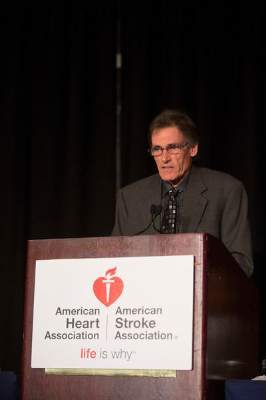User login
BALTIMORE – Higher levels of fitness were associated with markedly reduced overall health care costs for a large group of service veterans, with annualized age-adjusted costs over a third lower when compared with the least-fit quartile.
Fitness was a stronger predictor of overall costs than any other variable assessed in the Veterans Exercise Testing Study (VETS), Dr. Jonathan Myers of the VA Palo Alto Health Care System and Stanford (Calif.) University reported at the American Heart Association Epidemiology and Prevention, Lifestyle and Cardiometabolic Health 2015 Scientific Sessions.
“Fitness,” Dr. Myers noted, “is a powerful predictor of risk, but few data exist that have associated health costs with objective measures of fitness.” To address this gap in the literature, Dr. Myers and his colleagues captured maximal exercise test results from the VETS cohort and capitalized on the availability of cost data from the VA Allocation Resource Center for VETS participants.
The 9,945 study participants, all of whom had clinical indications for maximal exercise testing, were almost entirely male (98%), with a mean age of 58 years. The population had a mean body mass index of 29.0 kg/m2, just under the cutoff for obesity. Nearly half (43%) had a history of cardiovascular disease, 27% had hypertension, 19% had diabetes, and only 1% had heart failure. Mean follow-up time was 10.7 years.
Participants’ results on maximal exercise testing were expressed as a percentage of the age-predicted peak metabolic equivalents (METS) achieved and stratified into quartiles of <60%, 60%-80%, 80%-100%, and >100% of age-expected peak METs. Multiple regression techniques were used to assess the contribution of exercise test results and clinical characteristics to overall health care costs.
The investigators also examined costs in a variety of ways: total aggregated cost over the study period, cost per patient per study year, and median annualized cost. For all analyses, a highly significant correlation (P <.0001) existed between level of fitness and health care costs. Each additional MET achieved on exercise testing, the investigators calculated, saved $1,592.
Health care costs generally maintained the inverse relationship with fitness across the gradient from most to least fit. Median age-adjusted annualized costs from most- to least-fit quartile, for example, were $10,600, $11,900, $11,300, and $12,600.
Study limitations included the study’s overwhelmingly male makeup, though Dr. Myers noted that there would be no reason to expect different results in women. Additionally, investigators could only obtain data for overall costs, without a breakdown of inpatient vs. outpatient expenditures. In analysis, models were not fully adjusted for comorbidities, either at baseline or during the study course.
In response to a question from the audience about the relative benefits of statin use when compared with enhanced physical fitness, Dr. Myers responded, “It’s been shown that fitness trumps statins for outcomes in the VA data.”
The results presented in this study “provide objective economic-based evidence for employers, health care professionals, and professional organizations to promote physical activity” not only as a means of enhancing well-being, but as a common-sense way to hold down health care costs, Dr. Myers concluded.
The study was funded by the Veterans Affairs Health Care System. No authors reported financial disclosures.
BALTIMORE – Higher levels of fitness were associated with markedly reduced overall health care costs for a large group of service veterans, with annualized age-adjusted costs over a third lower when compared with the least-fit quartile.
Fitness was a stronger predictor of overall costs than any other variable assessed in the Veterans Exercise Testing Study (VETS), Dr. Jonathan Myers of the VA Palo Alto Health Care System and Stanford (Calif.) University reported at the American Heart Association Epidemiology and Prevention, Lifestyle and Cardiometabolic Health 2015 Scientific Sessions.
“Fitness,” Dr. Myers noted, “is a powerful predictor of risk, but few data exist that have associated health costs with objective measures of fitness.” To address this gap in the literature, Dr. Myers and his colleagues captured maximal exercise test results from the VETS cohort and capitalized on the availability of cost data from the VA Allocation Resource Center for VETS participants.
The 9,945 study participants, all of whom had clinical indications for maximal exercise testing, were almost entirely male (98%), with a mean age of 58 years. The population had a mean body mass index of 29.0 kg/m2, just under the cutoff for obesity. Nearly half (43%) had a history of cardiovascular disease, 27% had hypertension, 19% had diabetes, and only 1% had heart failure. Mean follow-up time was 10.7 years.
Participants’ results on maximal exercise testing were expressed as a percentage of the age-predicted peak metabolic equivalents (METS) achieved and stratified into quartiles of <60%, 60%-80%, 80%-100%, and >100% of age-expected peak METs. Multiple regression techniques were used to assess the contribution of exercise test results and clinical characteristics to overall health care costs.
The investigators also examined costs in a variety of ways: total aggregated cost over the study period, cost per patient per study year, and median annualized cost. For all analyses, a highly significant correlation (P <.0001) existed between level of fitness and health care costs. Each additional MET achieved on exercise testing, the investigators calculated, saved $1,592.
Health care costs generally maintained the inverse relationship with fitness across the gradient from most to least fit. Median age-adjusted annualized costs from most- to least-fit quartile, for example, were $10,600, $11,900, $11,300, and $12,600.
Study limitations included the study’s overwhelmingly male makeup, though Dr. Myers noted that there would be no reason to expect different results in women. Additionally, investigators could only obtain data for overall costs, without a breakdown of inpatient vs. outpatient expenditures. In analysis, models were not fully adjusted for comorbidities, either at baseline or during the study course.
In response to a question from the audience about the relative benefits of statin use when compared with enhanced physical fitness, Dr. Myers responded, “It’s been shown that fitness trumps statins for outcomes in the VA data.”
The results presented in this study “provide objective economic-based evidence for employers, health care professionals, and professional organizations to promote physical activity” not only as a means of enhancing well-being, but as a common-sense way to hold down health care costs, Dr. Myers concluded.
The study was funded by the Veterans Affairs Health Care System. No authors reported financial disclosures.
BALTIMORE – Higher levels of fitness were associated with markedly reduced overall health care costs for a large group of service veterans, with annualized age-adjusted costs over a third lower when compared with the least-fit quartile.
Fitness was a stronger predictor of overall costs than any other variable assessed in the Veterans Exercise Testing Study (VETS), Dr. Jonathan Myers of the VA Palo Alto Health Care System and Stanford (Calif.) University reported at the American Heart Association Epidemiology and Prevention, Lifestyle and Cardiometabolic Health 2015 Scientific Sessions.
“Fitness,” Dr. Myers noted, “is a powerful predictor of risk, but few data exist that have associated health costs with objective measures of fitness.” To address this gap in the literature, Dr. Myers and his colleagues captured maximal exercise test results from the VETS cohort and capitalized on the availability of cost data from the VA Allocation Resource Center for VETS participants.
The 9,945 study participants, all of whom had clinical indications for maximal exercise testing, were almost entirely male (98%), with a mean age of 58 years. The population had a mean body mass index of 29.0 kg/m2, just under the cutoff for obesity. Nearly half (43%) had a history of cardiovascular disease, 27% had hypertension, 19% had diabetes, and only 1% had heart failure. Mean follow-up time was 10.7 years.
Participants’ results on maximal exercise testing were expressed as a percentage of the age-predicted peak metabolic equivalents (METS) achieved and stratified into quartiles of <60%, 60%-80%, 80%-100%, and >100% of age-expected peak METs. Multiple regression techniques were used to assess the contribution of exercise test results and clinical characteristics to overall health care costs.
The investigators also examined costs in a variety of ways: total aggregated cost over the study period, cost per patient per study year, and median annualized cost. For all analyses, a highly significant correlation (P <.0001) existed between level of fitness and health care costs. Each additional MET achieved on exercise testing, the investigators calculated, saved $1,592.
Health care costs generally maintained the inverse relationship with fitness across the gradient from most to least fit. Median age-adjusted annualized costs from most- to least-fit quartile, for example, were $10,600, $11,900, $11,300, and $12,600.
Study limitations included the study’s overwhelmingly male makeup, though Dr. Myers noted that there would be no reason to expect different results in women. Additionally, investigators could only obtain data for overall costs, without a breakdown of inpatient vs. outpatient expenditures. In analysis, models were not fully adjusted for comorbidities, either at baseline or during the study course.
In response to a question from the audience about the relative benefits of statin use when compared with enhanced physical fitness, Dr. Myers responded, “It’s been shown that fitness trumps statins for outcomes in the VA data.”
The results presented in this study “provide objective economic-based evidence for employers, health care professionals, and professional organizations to promote physical activity” not only as a means of enhancing well-being, but as a common-sense way to hold down health care costs, Dr. Myers concluded.
The study was funded by the Veterans Affairs Health Care System. No authors reported financial disclosures.
AT AHA EPI/LIFESTYLE 2015
Key clinical point: Health care costs are significantly lower for the most-fit service veterans.
Major finding: Health care costs for the most-fit quartile of a group of veterans were 35% lower than for the least-fit quartile, and fitness was a stronger predictor of cost than any other clinical variable.
Data source: Nearly 10,000 veterans enrolled in an ongoing prospective study were undergoing clinically indicated maximal exercise testing at two VA hospitals, with costs assessed in 2005 and 2012.
Disclosures: The study was funded by the Veterans Affairs Health Care System. No authors reported financial disclosures.

